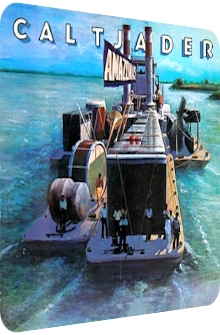
Cal Tjader
Amazonas
1976
Amazonas by mallet instrumentalist Cal Tjader (1925–1982) is an eight-track LP recorded in Los Angeles in June 1975 and released in the following year on Fantasy Records. Amazonas is primarily known for its wide use of electronic devices next to such classic instruments as the piano, a pair of bongos or the bandleader’s vibraphone and marimba. Torn between Funk, Batucada, Samba and exotic peripheries of all kinds, the album offers the genuine Tjaderism of rapidly changing instruments, patterns and textures.
The leader is at the helm of a septet here, the other six musicians being bassist Loiz Alves, flutist Hermeto Pascoal, guitarist David Amaro and drummer and percussionist Robertinho Silva, with keyboarder Dawilli Gonga and pianist and synthesizer player Egberto Gismonti grafting the ethereal droplets and legato washes onto the spacily verdured constructions. A few guest musicians appear on the album as well. The melodies are rarely hummable, as the textures are the actual stars and expand the memorability a lot. Renditions and original visions are happily united here. There are undoubtedly people out there who strongly prefer the original 50’s minimalism of Cal Tjader. But one thing is for sure: the vibraphonist has entered so many decades, changed and opened his style so many times that one cannot simply love all of his works equally, I presume. This is where Amazonas comes into play. It is one of his latter works and bursts at the seams due to a variety of fleeting melodies and Ambient flumes. Polymorphous and ever-shifting, it is definitely shiny and stylistically close to the boundless Jazz adventures of the 80’s. But is it an exotic work?
The eponymous opener Amazonas is a take on João Donato‘s composition that is usually associated with classic big band setups. Here, however, the septet injects a huge dose of Funk to the setting and ameliorates this meandering appearance with terraqueous glints. The rendition starts in medias res, with Robertinho Silva’s clinging cymbals and Egberto Gismonti’s refreshingly blue-tinted electric piano sparks already intact. Cal Tjader joins Luiz Alves’ wobbling bass fundament with pointillistic marimba droplets. The city-strolling beat structure and the dry bass blebs are much more rooted in a concrete jungle than in the rain forests out there, but the eclectic yet accessible mixture of textures makes this an uplifting and slick Funk tune. David Amaro’s work on the guitar is almost swallowed by the synthetic intertwinement. The electronic ingredients outweigh the jazzy ones, the ensuing duality is still wonderfully encapsulated in an electro-acoustic alloy.
The exotified journey continues with Xibaba, written by Tjader’s friend and producer Airto Moreira. A clear cut progressive piece whose voluminosity and density grows during its runtime of almost six minutes, Xibaba’s humble beginnings comprise of ethereal Ambient structures as delivered by Gismonti’s synthesizers which are then ameliorated by Tjader’s vibraphone greenery, several mystical wind chimes and Silva’s cautious bongo accentuations. The setting is wondrously purified and euphonious, yet enigmatic and distant. The electric piano works well in tandem with the vibraphone, and the spawned tone sequences are delightfully tropical and fragile. Wah-wah guitars bring this forest back to the funkier side, whereas flutist Hermeto Pascoal contravenes these efforts by maintaining the allusion of Pagan coppices. The percussion grows louder and more convoluted, snake-evoking shakers rattle through the thicket, and even though the melody remains eminently dreamy and poeticizing, the upbeat percussion towers above the placidity and boosts the notion of motion.
While Cal Tjader’s and Hermeto Pascoal’s own Mindoro draws from a pentatonic phantasmagoria via the polyphonous marimba droplets, coruscating glints and flute coils par excellence which are altogether embedded in an elysian setting driven by synth accompaniments and percussive underbrushes fueled by hi-hats, guitarist David Amaro’s Flying closes side A and shows his skillfully progressive dreaminess on his signature instrument which serves as a backdrop for the feisty kick drums, Tjader’s orbiting vibe shards and the shimmering blanket of spacey-spacious Ambient structures which soften the fissured structure of this insouciant piece.
What is basically the most laid-back piece of the album, Corine by the album’s arranger George Duke, launches side B in a languorous fashion. Dawilli Gonga’s punchy keyboard dots conflate with an easygoing wah-wah Funk glitz, electric piano stalactites and an enchanting vibraphone. The midtempo allows the afterglow of the textures to fathom out the mauve-colored synth strings in the background. Corine reminds of Tjader’s album Solar Heat (1969) but augments the artificial sound layers further. A superb tune which is followed by a rendition of Sérgio Mendes’ Noa Noa starring guest trombonist Raul De Souza who brings a darker, more rural and rustic flavor to the otherwise blazingly translucent cowbell-driven crystal cavern. Electric pianos, vibes and cowbells induce an aeriform exhilaration that is undoubtedly enthralling and refreshingly icy.
Tamanco No Samba by Orlandivo Honório de Souza and Roberto Jorge then features another guest musician, pianist Aloisio Milanez whose classically Latin instrument seems like a foreign substance in the opalescent grove. The amount and abundance of firefly-evoking bits, vesicles and chimes continues to shine in this Batucada hymn, the breakneck speed of all involved instruments results in an excitingly gaseous and humid landscape. Robertinho Silva’s work on the drums is particularly noteworthy. The closing track is Airto Moreira’s Cahuenga which lures the listener with its dualistic tempo and the various shifts. They rarely feel like shifts. Translatable as “little mountains”, Cahuenga oscillates between completely beatless piano solos which lead to soft bongo movements and flute breezes on the one hand, and tramontane mountainous protuberances on the other hand. It proves to be the weakest track due to the crammed tohubohu. The solution to this canned density comes years later on the CD reissue where a long version of nine and a half minutes puts the focus on the piano and stretches the hectic frenzy, thus making it appear less bustling.
Amazonas is a work full of synergies, fusions, electronic gadgetry and hence lives up to the open mind of Cal Tjader which was especially characteristic in his later work phase that embraced electronic devices. Melodies are few and far between, but it takes a genius to hum along to them. The staccato nature, the energetic shrapnel of short eruptions and sudden textural changes as well as the huge amount of synthesizers and keyboards might not be everyone’s cup of tea, but there is no doubt about the principal triggers of Exotica: a certain yearning, a designed distortion of the overarching topic and interpretations that are as free as the cavalcade of improvisations make this a worthy contender to 70’s post-Exotica dobs such as Raices’ self-titled and only release from 1974 or John Klemmer’s Brazilia (1979) which shares many a characteristic trait with Amazonas, for instance the gelid tittles of the electric piano.
On Amazonas, Tjader remains curiously under the radar whenever he plays the vibraphone, although he is a prominent part in each and every arrangement. The instrument meshes really well with the adjacent textures, for better or worse. When he plays the marimba though, he leads the band more transparently and admixes an interesting semi-wooden surface to the textural pool. I oftentimes wonder what Cal Tjader would have done in the middle of the 80’s. Would he have further expanded the synthetic parts of his music and injected piles of synthesizers akin to the Pat Metheny Group? One can almost be sure that this would have been the case indeed. Amazonas comes pretty close to this hypothetical thought experiment. It could be a work that introduces contemporary listeners to the world of Exotica due to its twinkling appearance and rapid succession of patterns. A hyperventilating but strongly accessible work.
Exotica Review 256: Cal Tjader – Amazonas (1976). Originally published on Aug. 31, 2013 at AmbientExotica.com.
